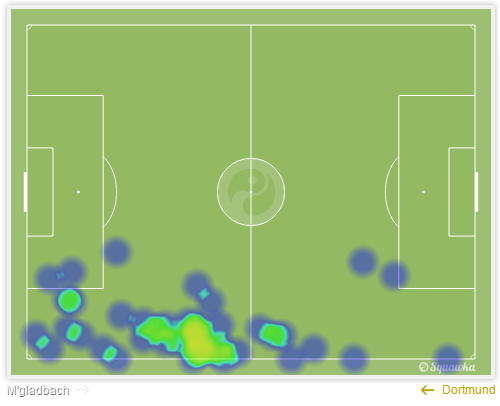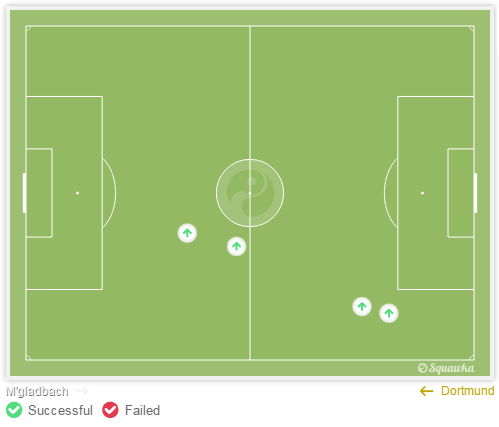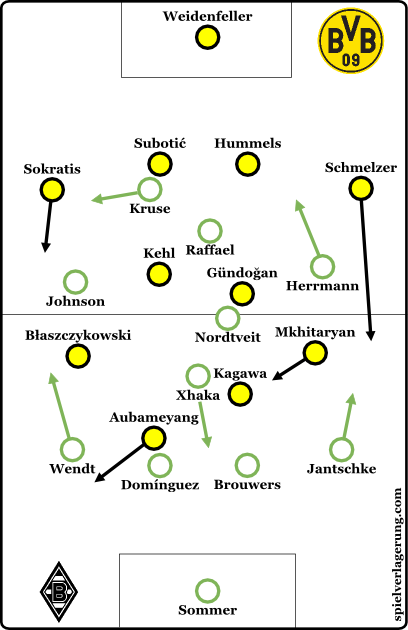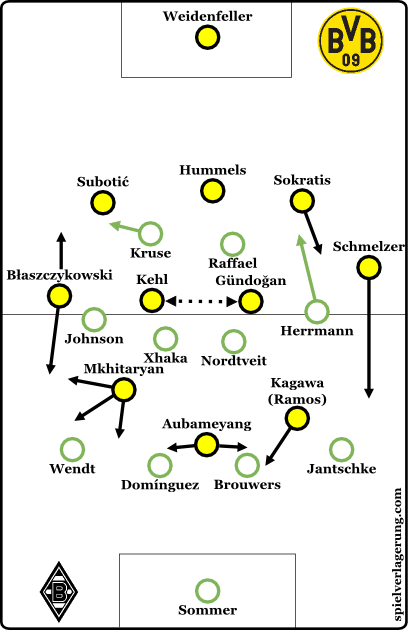Borussia M’Gladbach – Borussia Dortmund 3:1
Borussia Dortmund’s disappointing campaign is about to continue. Mönchengladbach punished Klopp’s side on the break clinically. Hence the Foals wrapped the Clash of Borussias up what means third-placed Gladbach are now guaranteed to finish ahead of BVB in the standings for the first time since 1989.
- Herrmann out-paced each and every one on the pitch
- Dortmund got frequently caught on the break
- Klopp changed the formation after the interval
Basic formation
Both coaches did not surprise with their line-ups. Klopp stuck to Dortmund’s customary 4-2-3-1 shape, with offensively limited Sokratis replacing Erik Durm at right-back and Sebastian Kehl playing instead of Sven Bender. Jakub Błaszczykowski, Shinji Kagawa, and Henrikh Mkhitaryan were fielded behind lone striker Pierre-Emerick Aubameyang.
As for Gladbach, Lucien Favre had to replace Christoph Kramer, who was suspended due to five yellow cards he had received. The 24-year-old scored a ridiculous own goal, when these two teams met for the first time in the season. This time Håvard Nordtveit played alongside Granit Xhaka in centre midfield. As to the rest, Favre placed his trust in the likes of Max Kruse and Raffael up front, while Patrick Herrmann and Fabian Johnson were asked to bomb on down the flanks.
First minute and its consequences
Undoubtedly, Dortmund initially intended to get comfortable on the ball, dominating the first phase of the match. However, for the third time in this Bundesliga campaign, Klopp’s side conceded an early goal. The Schwarzgelben were caught cold inside 30 seconds as Herrmann broke through the right half-space and exchanged slick passes with Raffael. While Mats Hummels was slipping, the Brazilian forced goal-keeper Roman Weidenfeller into action. Weidenfeller blocked the ball right into Oscar Wendt’s path who gave thanks for that.
Despite an early set-back, Dortmund stuck to their plan, seeing plenty of possession. However, the early lead played naturally into Gladbach’s hands. The Foals defended in a vertically close 4-4-2, with Kruse and Raffael blocking the centre against Hummels’ passes. To avoid Dortmund’s threating counter attacks, Kruse sometimes tracked back down the left, occasionally creating a 4-5-1. It was text book Gladbach.

Marcel Schmelzer’s heatmap in the frist 45 | Squawka.com
Dortmund did not find the desperately needed space in the final third, while showing problematic staggerings. Particularly Kagawa tended to stay up front, where he was covered between Gladbach’s physically superior centre-backs. The small Japanese did not show enough confidence to link up with the centre midfielders in deeper spaces. In terms of possession play, İlkay Gündoğan was Dortmund’s pivot positioned right in the middle, while Kehl changing position horizontally. Though, Gündoğan could not find the right spots to play his dangerous through balls. As mentioned, Kagawa stood too high, and Aubameyang tended to drift out wide on the break as well as in longer spells of possession. Moreover, Sokratis, who clearly feels more comfortable at centre-back, hung back on the right side. As a consequence, Gündoğan looked for Dortmund’s right-back to play the ball to the right side several times, but he needed to defer the attacks giving Sokratis enough time to advance.
Meanwhile, Dortmund’s left side seemed to be more promising. Mkhitaryan usually drifted inwards, filling in the no. 10’s space, while Schmelzer displayed great attacking presence. The 27-year-old left-back ran back and forth, giving width in the final third, while also covering Herrmann in the own third. His crossing accuracy has changed for the better lately, but Dortmund lack target players in the box to convert such crosses, albeit Aubameyang scored with a header against Hoffenheim last Tuesday.
“We defended very deep – I think we were probably a bit too deep. BVB played well – they played to their limit.” (Lucien Favre)
Gladbach sniff their chance
Overall, Dortmund’s display seemed familiar: domination without penetration. On the other side, Favre’s team built up attacks calmly, with Xhaka dropping between the centre-backs. Nordtveit was squeezed between Kagawa and Aubameyang, as Dortmund tried to block the centre. However, Gladbach sometimes could avoid the pressure, bypassing Dortmund’s front line with quick passes to the full-backs. This was possible because of BVB’s relatively passive pressing approach behind the halfway line. Mkhitaryan occasionally attacked Roel Brouwers from inside out. But altogether, Gladbach gained a couple of chances when Dortmund offered space between the lines and did not put enough pressure on space and ball carrier. Especially Raffael sneaked between Dortmund’s midfield line and back four. He overall received five diagonal passes from both full-backs and eight vertical passes from both centre midfielders.

Patrick Hermann’s dribble attempts | Squawka.com
Despite Dortmund was able to intercept a couple of balls, the passes to Mkhitaryan and Błaszczykowski that should unleash BVB’s transition attacks were just predictable. Furthermore, due to Aubameyang’s evasive movement the Gabonese was isolated near the touchline quite often.
As the half progressed, the Foals continue to soak up Dortmund’s pressure, while looking to catch the opponents out on the break. And exactly that happened in the 32th minute when Kruse was attacked by Hummels near the halfway line, while Dortmund’s skipper was exposing the back line. Kruse was able to release Herrmann. The 24-year-old speedy winger passed Kehl by and out-aubameyanged Neven Subotić, before squaring for Raffael to roll into the empty net.
“It’s a mixture of good intentions, defending high up the pitch and a lack of consistency … Each goal we conceded today was nonsense, even though there were various problems on our part.” (Jürgen Klopp)
Dortmund rediscovered the back three
Being two goals behind, Klopp utilized unusual adjustments. After the half-time, Dortmund played in a 3-4-2-1 formation until the final whistle, with Schmelzer and Błaszczykowski being used as wing-backs. The last time we saw Dortmund playing a back three was in October of 2012 when Klopp unsuccessfully tried this kind of formation in the prestigious Revierderby against Schalke.
However, this time we could notice appealing rudiments. While building up, Dortmund’s back three stood widely, with Hummels using free space to dribble forwardly and giving Gündoğan more freedom. What remained dubious was Kagawa’s role. He still pushed into the box trying to catch long balls. Consequently, Klopp put Adrián Ramos on for Kagawa, because the Columbian can offer more vigour in the air.
But Dortmund still struggled defensively. Subotić was asked to man-mark Kruse who sought free space on the left in well-known fashion. On the other side of the pitch, Herrmann was still determined to run down his opponents. Particularly Sokratis could not catch Gladbach’s speedster. Later in the game, Klopp would introduce wing-back Jeremy Dudziak to let him play man-orientated against Herrmann.
After Dortmund arguably enjoying their best spell of the match, Gladbach crushed BVB’s last hopes. Following a Kruse corner, Wendt crossed wide from a tight angle, before Nordveit swiped home a third goal. Gladbach eventually allowed Dortmund to reduce the arrears when Dudziak had plenty of time on the left already standing in the Foals’ box. Gündoğan converted an accurate cut-back from Dudziak.
Conclusion
Gladbach cements their position in Bundesliga’s top four. Of course, Favre’s side benefited from an early lead, as they could play off their biggest strength from then on. When defending in 4-4-2 with vertically tight lines, Gladbach are in a class of their own. As for Dortmund, the campaign remains to be some sort of a roller coaster ride. The lack of ideas against deep sitting teams still troubles Klopp. BVB’s attacking players often stand too flat in the final third, while deeper playmakers desperately looking for open spaces and men. Pointlessly crossing the ball cannot be the solution as long as Aubameyang and Kagawa are your target players…


5 Kommentare Alle anzeigen
Mikee Likee April 12, 2015 um 4:53 pm
Just don’t understand, why Dortmund couldn’t take advantage of their 3-4-3 against the Gladbach’s 4-4-2. The benefit of back 3 is the free space for the both half defenders to move forwardly into middle, and both Hummels and Sokratis (Dudziak even more) have the ability to do so, plus Gundogan is good enough to create superior formations for breakthroughs, so that they could complete the attack 4 vs 4.
Maybe I’m a minority, but i believe the stability of Gladbach’s 4-4-2 is bit overrated, albeit very successful. And I’m very curious about the Why.
blub April 12, 2015 um 6:56 pm
The 343 was, as far as we know, not trained and I’m sure they would’ve taken better use of there advantages if they had.
Gladbach’s 442 is as good as a passive 442 can get apart from Atletico Madrid.
They basicly make no positional mistakes for the whole game.
It will get pretty interesting when they will not get the opportunity to counterattack (like the BVB this season), but it’s often overlooked that their own buildup is very good, too.
Mikee Likee April 12, 2015 um 7:05 pm
Inspected 😉
blub April 12, 2015 um 9:17 am
Just watched the summary of the game on sky and they didn’t even mention the change of formation.
And I’m pretty sure even they can’t be so bad not to see that.
I just want to cry.
blub April 12, 2015 um 9:01 am
It’s still a loss, but I consider it not as bad as before this season.
Getting stuck in Gladbach’s deep 442 shape is something else as getting stuck in semi-compact 442 against Köln, Dresden or HSV. Still no reason to get cought on the break this badly.
The one time that Gladbach didn’t look good this season was in their previous match against Dortmund.
Im pretty sure the BVB from this game would’vs crushed HSV and Köln.